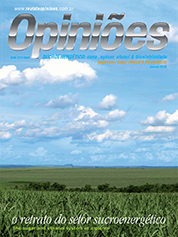Marcus Vinicius Pratini de Moraes
Former Minister of Agriculture, of Mines and Energy and of Industry and Trade
Op-AA-25
Marketing, logistics, aggregation of value
The consumption of food, plant fibers and agricultural raw materials is expected to double by 2050, according to FAO projections. In the past century, economic growth processes were always commanded by the U.S., European and Japanese markets. Since the end of the 20th Century, the world’s trading geography has changed and nowadays the dynamic poles of economic growth have shifted to emerging countries, with China leading the process in all areas.
In the field of food, cellulose, and more importantly, animal and plant protein, Brazil plays the new lead role, while also having an expressive and increasing presence in cotton. Expectations are that the Brazilian agro and cattle breeding production will double, and in some industries production may even triple, in the next 40 years.
In several studies carried out on trends in world demand for agro and cattle breeding products, one can see that most growth in consumption will be in sugar, ethanol, oleaginous products, meat, dairy products and eggs. Brazil uses only 5.4% of its 851 million hectares to produce 145 million tons of annual grain crops, and of the 220 million hectares of natural and cultivated grazing lands, cattle breeding only uses 170 million hectares, whereas this figure tends to decrease as the productivity of bovine breeding increases.
The trend is to increase the agriculture/ cattle breeding integration and the use of quasi confinement for termination of animals to be slaughtered. We nowadays have 90 million hectares for new plantations, twice the figure we planted in the current harvest season. The Brazilian agro and cattle breeding industry faces an opportunity for a new leap in productivity and efficiency, as we had one in the first decade of this century.
There is no doubt in my mind that these new markets, which grow through the increase in income in emerging countries rather than through demographics, will need Brazil to be the supplier. To meet this new demand, there are two problems we must overcome: logistics and mar-keting. Logistics both at the domestic and international levels.
At the domestic level, the problem is not limited only to the volume of needed funds, but also to the traditional delay in public works, nowadays further delayed by the bureaucracy involving environmental issues. In marketing, what needs to be defined are institutional actions which are the competence of the government, and trade initiatives that more directly involve private initiative, but for which government actions are also important to the extent tariff, sanitation and environmental protectionism prospers.
The public sector’s role is to open new markets and preserve those that already exist, when threatened by protectionist actions in any of the three forms referred to above. Another essential priority is the need to foster internationalization of our companies, to take their operations to the consumer markets. In other words, it is necessary to increase distribution productivity, like we did with production productivity.
In production, beginning with the expansion of “in straw planting” areas and successful investments in animal and plant genetics, we reached among the highest productivity levels in the world. But, what is gained in production is lost in logistics. It is appropriate to recall that Brazil is a “far away” country from consumer markets, and, in particular, from those that grow the most, in Southeast Asia. In addition, the main production regions are distant from the ports.
Nowadays, the logistics challenge is more complex, requiring more time and money, but it is also the factor that will define the feasibility of increasing agro and cattle breeding production. Another important issue is the increase in production’s aggregated value. Although many would prefer Brazil to be a raw materials’ exporter, our progress in some industries, such as meat, is extraordinary.
However, this implies expanding marketing actions, both institutionally and commercially. Agro and cattle breeding links must cooperate more harmoniously. The government and the private sector must perform together to make feasible the increase in aggregated value of primary production.
Of course, Brazil will always be an exporter of commodities as well, but at the current costs of logistics and with an overvalued foreign exchange rate of at least 20%, we will gradually lose competiti-veness. At the point we have reached, it is essential to increase animal protein exports, which has ten to twenty times the plant protein from which it originates and therefore supports higher logistics costs.
In this pre-electoral phase, when one debates strategic topics concerning the future of the Nation, it is the right time to set the direction for agribusiness. Do we intend to follow the model proposed by competitors? They want Brazil to limit its production to domestic demand and to transform itself into a huge forest, reaching from the Amazon region to the southernmost border at Chui. Is that what we want?




